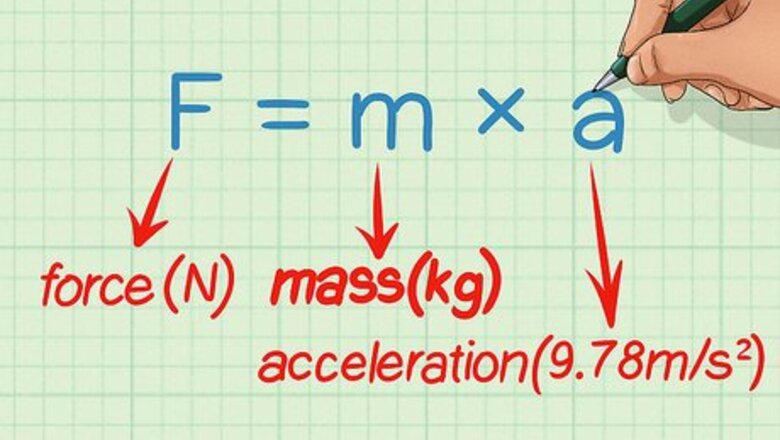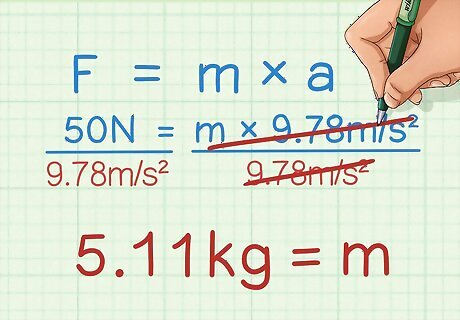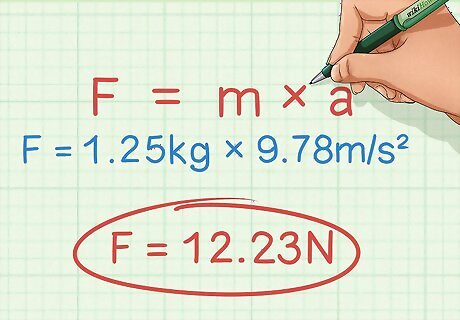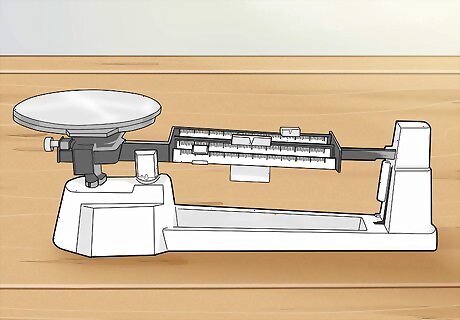
views
X
Research source
Weight is the effect that gravity has on an object. Mass is the amount of matter in an object irrespective of the effect that gravity has on it. If you were to move a flagpole over to the Moon, its weight would be reduced roughly by 5/6, but its mass would stay the same.[2]
X
Research source
Converting Weight and Mass

Know that F (force) = m (mass) * a (acceleration). This simple equation is what you'll use to convert weight into mass (or mass into weight, if you want to). Don't be worried about what the letters mean — we'll tell you: Force is the same thing as weight. Use Newtons (N) as weight. Mass is what you're solving for, so it may not be defined to begin with. After solving the equation, your mass will be calculated as kilograms (kg). Acceleration is the same thing as gravity. Gravity is on earth is a constant equaling 9.78 m/s. If you're measuring gravity on other planets, this constant will be different.

Convert weight into mass by following this example. Let's illustrate how to convert weight into mass by using an example. Say you're on earth and you're trying to figure out how much mass your 50 kg soapbox racer has. List your equation. F = m * a. Fill in your variables and constants. We know that force is the same thing as weight, which is 50 N. We also know that the effect of gravity on earth is always 9.78 m/s. Plug in both numbers and our equation looks like this: 50 N = m * 9.78 m/s Rearrange in order to solve. We can't solve the equation like this. We need to divide 50 kg by 9.78 m/s in order to isolate m. 50 N / 9.78 m/s = 5.11 kg. A soapbox racer that weighs 50 Newtons on Earth has a mass of about 5 kg, wherever you race it in the universe!

Convert mass into weight. Learn how to convert mass back into weight using this example. Let's say that you pick up a moon rock on the surface of the Moon (where else?). It has a mass of 1.25 kg. You want to know how much it will weigh when you bring it back to earth. List your equation. F = m * a. Fill in your variables and constants. We have mass and we have the gravitational constant. We know that F = 1.25 kg * 9.78 m/s. Solve the equation. Because the variable we're looking for is already isolated on one side of the equation, we don't have to do any moving around in order to solve the equation. We simply multiply 1.25 kg by 9.78 m/s, giving us 12.23 Newtons.
Measuring Mass Without Equations

Measure gravitational mass. You can measure mass using a balance. A balance is different from a scale because it uses a known mass to measure the unknown mass where as a scale actually measures weight. Finding mass with a triple-beam balance or a double-pan balance is a form of measuring gravitational mass. This is a static measurement, which means it is only accurate when the object being measured is at rest. A balance can measure weight and mass. Because the measurement of the balance weights change by the same factor as the object being measured, a balance is able to accurately provide the mass of an object regardless of the specific gravity of the environment.

Measure inertial mass. Inertial mass is a dynamic measuring method, meaning that it can only be accomplished while the object being measured is in motion. The inertia of the object is used to quantify the amount of matter. An inertial balance is used to measure inertial mass. Secure the inertial balance to a table. Calibrate the inertial balance by putting the container in motion counting the number of vibrations in a specified time period, for example 30 seconds. Place an item of known mass in the container and repeat the experiment. Continue using several items of known mass to finish calibrating the scale. Repeat the experiment with an item of unknown mass. Graph all results to find the mass of the final object.















Comments
0 comment